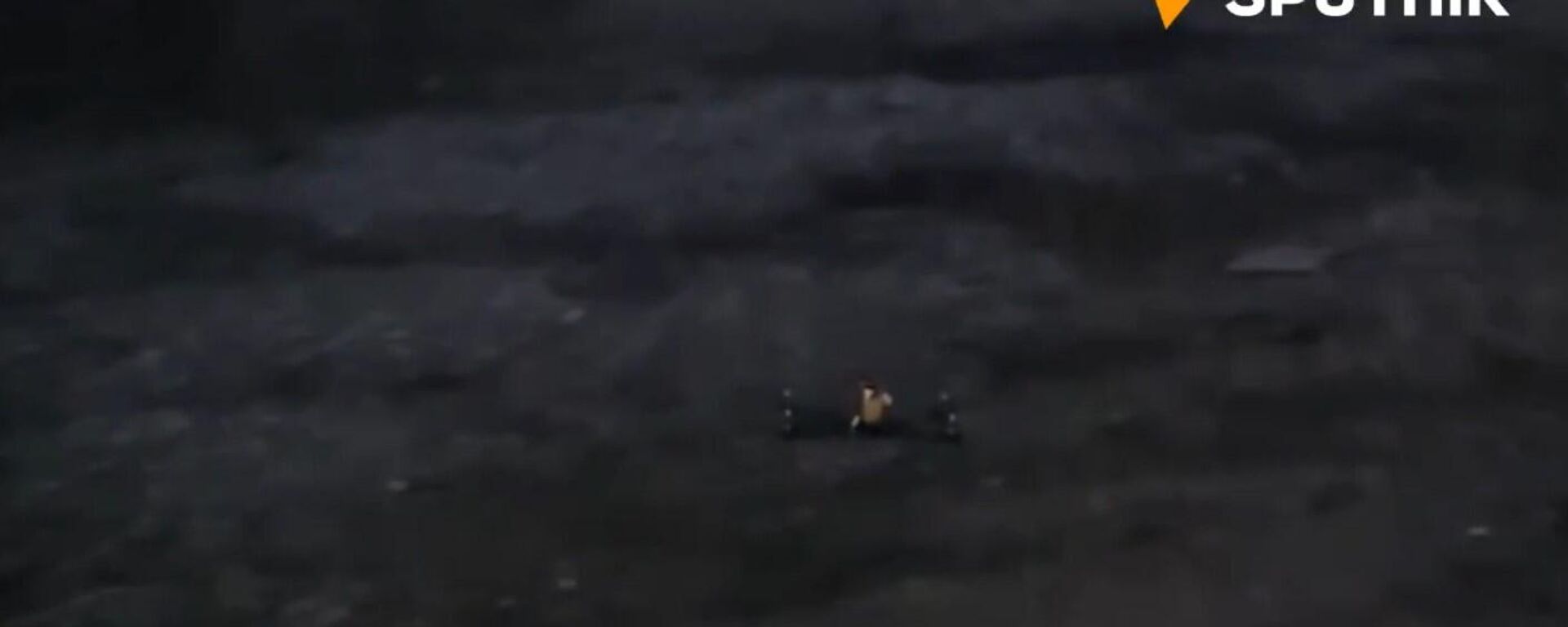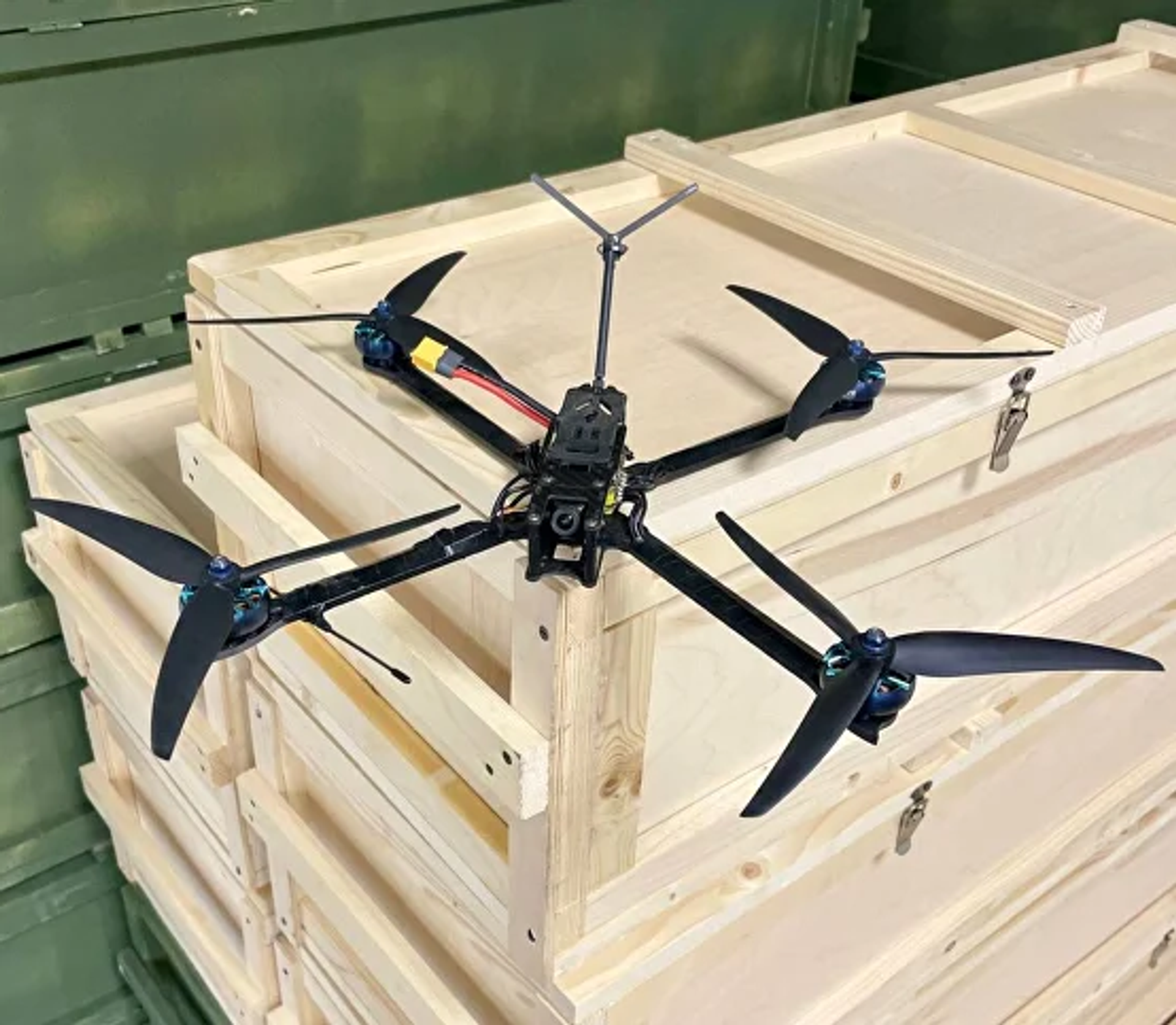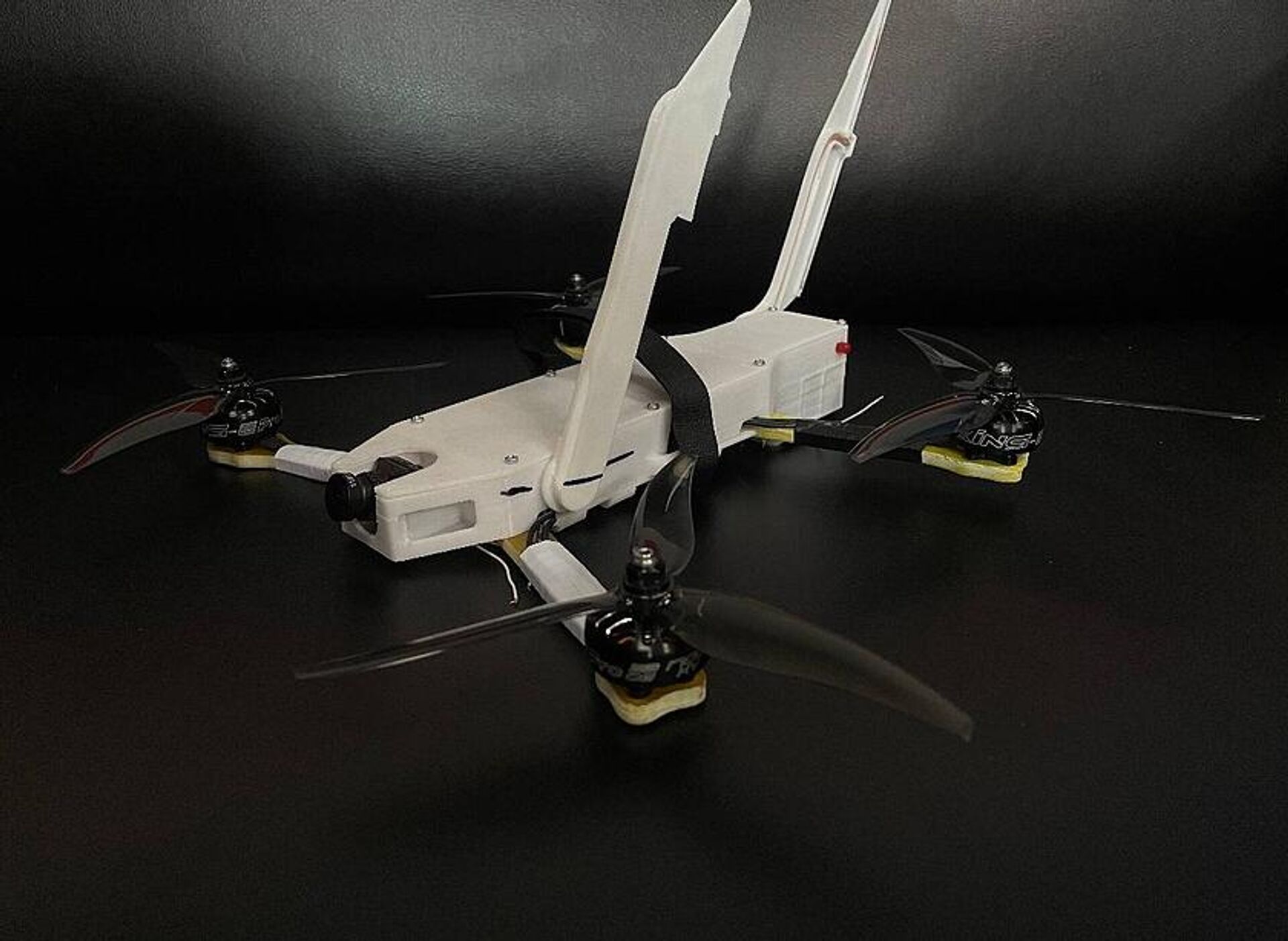https://sputnikglobe.com/20240101/how-russian-first-person-view-drones-change-the-frontlines-1115932708.html
How Russian First-Person View Drones Change the Frontlines
How Russian First-Person View Drones Change the Frontlines
Sputnik International
The swift deployment of advanced kamikaze drones such as the "Hortensia," "Upir," and "Boomerang" into military operations by the Russian army, as the conflict in Ukraine continues, heralds a strategic shift in modern warfare and alters defense strategy dynamics.
2024-01-01T19:27+0000
2024-01-01T19:27+0000
2024-01-02T06:24+0000
military
military & intelligence
dmitry chernyshenko
russia
ukraine
vladimir
defense ministry
russian government
russian army
rpg-7
https://cdn1.img.sputnikglobe.com/img/07e7/0a/04/1113918100_0:161:3071:1888_1920x0_80_0_0_c60cb9e13f5bbccba41119af6abebce9.jpg
in some cases, creating First Person View (FPV) drones, initially envisioned as a personal passion project, have transformed into formidable tools for aerial combat operations, research activities, photography, videography, cadastral mapping, etc.The Russian Army, renowned for its technological advancements, has embraced the capabilities of FPV drones, integrating them into its reconnaissance and surveillance operations.The integration of FPV drones by the Russian Army manifested a strategic shift towards modernized warfare tactics, highlighting real-time battlefield data capturing, improved situational awareness, and tactical advantages during active duty. These drones, equipped with high-resolution cameras and advanced navigational systems, offer insightful analytics that allows the military to watch and sweep vast landscapes efficiently.As the Russian Army continues to enhance its drone capabilities, the technology and innovations derived from these military-grade FPV drones have yielded tremendous successes in the ongoing conflict in Ukraine.Sputnik explores the unique attributes, performance capabilities, and advancements of Russian FPV drones, particularly those developed or endorsed by the Russian military.Russian FPV Production and DevelopmentBefore the special military operation in 2022, Russia was still exploring FPV technologies. Notably, they had introduced unmanned aerial vehicles Grom, Okhotnik, and Orlan-10. However, their mass deployment wasn't on the horizon until the conflict in Ukraine accelerated their advancement.While large firms and design bureaus play a major role, FPV drone innovation in Russia is also driven by individual enthusiasts. These inventors are trailblazing kamikaze drone projects, often from makeshift "garage" facilities.Numerous innovations undergo immediate field tests in combat settings. Drones either validate their effectiveness or are returned for modifications based on military preferences.The Russian military's use of kamikaze drones has earned them a reputation as menacing aerial entities, attributing their reputation to consistent successful operations against enemy forces.Russian FPV Drones in CombatThe Russian military's use of kamikaze drones has earned them a reputation as menacing aerial entities, attributing their reputation to consistent successful operations against enemy forces.Experts point out that these drones excel in speed, maneuverability, and their aptitude for striking mobile targets."Hortensia" FPV DroneThe "Hortensia" is the first combat FPV drone designed for multiple combat assignments, encompassing intel gathering and cargo deliveries. Developed by St. Petersburg design bureau "Hortensia", and began deploying kamikaze drones in significant numbers to the frontlines in November 2023. The production capacity is 120 pieces per day, 3,000 drones per month, with each combat unit priced at approximately 40,000 Russian rubles (≈$450).There are 3 known models of this drone, each with distinct technical specifications.Hortensia 7Hortensia 10 (with Thermal Imagery)The bureau "Hortensia" told Russian news sources that including thermal imaging technology in FPV drone upgrades enables Russian military personnel to carry out nocturnal combat operations. This UAV is engineered to neutralize enemy personnel, dugouts/troughs, and lightly and heavily armored vehicles. It is capable of day and night missions and boasts precision in remote mining and bombing, according to the producer."Upir" FPV DroneIn the ongoing special military operation, the Russian armed forces in the Northern Military District deployed this drone first in combat operations. The project manager, Vladimir Tkachuk, told news sources that “Upir” (lit: Vampire), also known as Gadfly or Ghoul is called the “people’s drone” because it was produced without private investment or public money but with funds raised by subscribers of major Russian Telegram channels reporting daily goings-on on the frontlines.The "Gadfly" is a copter kamikaze drone specifically designed to transport RPG-7 ammunition, RKG-3M anti-tank grenades, and field-made explosive charges assembled by combatants on the frontline. Its 2kg payload lifting capability underscores its usefulness in conducting combat tasks, further enhanced by its streamlined aerodynamic design.The drone's design comprises specific features and software configurations, distinguishing it from standard FPV variants and boosting its resilience against enemy electronic warfare system interceptions.“Upir” gained fame on the battlefield for its capability to penetrate the designated tactical perimeter and engage targets up to 12km within enemy lines. Additionally, it excels in adverse weather conditions and navigates seamlessly through challenging wooded terrains and varied elevations. This type of drone costs around 50,000 Russian rubles (≈$560) to produce."Boomerang" FPV DroneIn March 2023, Russia's Defense Ministry unveiled the deployment of the Boomerang FPV drone to frontline operations. Described as analogous to a sports UAV, it features a specialized container packed with destructive materials, mainly plastic, and outfitted with an ignition system.St. Petersburg's OKO design bureau is at the forefront of drone innovation. Their Privet-82 FPV drone, engineered to transport up to 5.5 kg payloads, showcases a unique aircraft configuration. Unlike its kamikaze counterparts, such as the Hortensia, the Privet-82 takes a distinctive approach. Furthermore, OKO is amplifying its range with the Privet-120, designed for 20 kg explosive loads, and is actively crafting the surveillance-centric Privet-mini UAV.Does Deployment of FPV Drones Cater to Russia's Military Needs?The deployment of FPV drones by the Russian military demonstrates their resilience and adaptability in engineering modernized systems to meet the immediate needs of personnel, providing a strategic edge during active combat scenarios. A key noteworthy feature is the impressive efficiency of the producers of these weapon systems. They can manufacture hundreds of drones daily using 3D printing, as seen with the "Upir." The value chain is also marked by cost-effectiveness, particularly regarding replaceable parts and their effectiveness.What the Future HoldsPresident Vladimir Putin, on December 21, 2023, presided over a Strategic Development Council gathering, highlighting plans to roll out fresh national projects in 2024 after completing current ones.Therefore, starting January 1, 2024, a national project for developing UAS (unmanned aircraft systems) will be launched in Russia. Additionally, a new national project titled “Development of Unmanned Vehicles” is set to begin this year. Local media reports that Deputy Head of the Russian Government, Dmitry Chernyshenko, highlighted these initiatives. He stated that the primary goal of this project is to establish technological sovereignty within the Russian Federation in the realm of drone development.The project plans to allocate almost a trillion Russian Rubles (≈$11.2 billion) for its implementation. The national project will encompass five federal components: stimulating demand for domestic UAS, training personnel for UAV technology, promoting advanced technologies, developing infrastructure, ensuring safety, and establishing a specialized certification system for unmanned aerial vehicles. Furthermore, the project aims to advance the development, standardization, and mass production of UAVs and their components.
https://sputnikglobe.com/20231217/watch-first-night-version-of-russias-gastello-fpv-attack-drone-tested-in-special-op-zone-1115638032.html
russia
ukraine
vladimir
Sputnik International
feedback@sputniknews.com
+74956456601
MIA „Rosiya Segodnya“
2024
Chimauchem Nwosu
https://cdn1.img.sputnikglobe.com/img/07e7/09/01/1113046371_0:99:1536:1635_100x100_80_0_0_9c5c627283eca931c39fe4852bbb301c.jpg
Chimauchem Nwosu
https://cdn1.img.sputnikglobe.com/img/07e7/09/01/1113046371_0:99:1536:1635_100x100_80_0_0_9c5c627283eca931c39fe4852bbb301c.jpg
News
en_EN
Sputnik International
feedback@sputniknews.com
+74956456601
MIA „Rosiya Segodnya“
UAV units of Russian paratroopers destroy Ukrainian infantry near Artemovsk using drones
Sputnik International
UAV units of Russian paratroopers destroy Ukrainian infantry near Artemovsk using drones
2024-01-01T19:27+0000
true
PT1M31S
Sputnik International
feedback@sputniknews.com
+74956456601
MIA „Rosiya Segodnya“
Chimauchem Nwosu
https://cdn1.img.sputnikglobe.com/img/07e7/09/01/1113046371_0:99:1536:1635_100x100_80_0_0_9c5c627283eca931c39fe4852bbb301c.jpg
fpv drones, russian army, military-grade drones. kamikaze drones, hortensia fpv drone, upir fpv drone, boomerang fpv drone, uav technology, russian federation, drone development.
fpv drones, russian army, military-grade drones. kamikaze drones, hortensia fpv drone, upir fpv drone, boomerang fpv drone, uav technology, russian federation, drone development.
How Russian First-Person View Drones Change the Frontlines
19:27 GMT 01.01.2024 (Updated: 06:24 GMT 02.01.2024) The swift deployment of advanced kamikaze drones such as the "Hortensia," "Upir," and "Boomerang" into military operations by the Russian army amid the Ukrainian crisis, heralds a strategic shift in modern warfare.
in some cases, creating First Person View (FPV) drones, initially envisioned as a personal passion project, have transformed into formidable tools for aerial combat operations, research activities, photography, videography, cadastral mapping, etc.
The Russian Army, renowned for its technological advancements, has embraced the capabilities of FPV drones, integrating them into its reconnaissance and surveillance operations.
The integration of FPV drones by the Russian Army manifested a strategic shift towards modernized warfare tactics, highlighting real-time battlefield data capturing, improved situational awareness, and tactical advantages during active duty. These drones, equipped with high-resolution cameras and advanced navigational systems, offer insightful analytics that allows the military to watch and sweep vast landscapes efficiently.
As the Russian Army continues to enhance its drone capabilities, the technology and innovations derived from these military-grade FPV drones have yielded tremendous successes in the ongoing conflict in Ukraine.
Sputnik explores the unique attributes, performance capabilities, and advancements of Russian FPV drones, particularly those developed or endorsed by the Russian military.
Russian FPV Production and Development
Before the special military operation in 2022, Russia was still exploring FPV technologies. Notably, they had introduced unmanned aerial vehicles Grom, Okhotnik, and Orlan-10. However, their mass deployment wasn't on the horizon until the conflict in Ukraine accelerated their advancement.
While large firms and design bureaus play a major role, FPV drone innovation in Russia is also driven by individual enthusiasts. These inventors are trailblazing kamikaze drone projects, often from makeshift "garage" facilities.
Numerous innovations undergo immediate field tests in combat settings. Drones either validate their effectiveness or are returned for modifications based on military preferences.
The Russian military's use of kamikaze drones has earned them a reputation as menacing aerial entities, attributing their reputation to consistent successful operations against enemy forces.
Russian FPV Drones in Combat
The Russian military's use of kamikaze drones has earned them a reputation as menacing aerial entities, attributing their reputation to consistent successful operations against enemy forces.
Experts point out that these drones excel in speed, maneuverability, and their aptitude for striking mobile targets.
The "Hortensia" is the first combat FPV drone designed for multiple combat assignments, encompassing intel gathering and cargo deliveries. Developed by St. Petersburg design bureau "Hortensia", and began deploying kamikaze drones in significant numbers to the frontlines in November 2023. The production capacity is 120 pieces per day, 3,000 drones per month, with each combat unit priced at approximately 40,000 Russian rubles (≈$450).
There are 3 known models of this drone, each with distinct technical specifications.
Analog Video Transmission
Rechargeable Battery: LiPo 4s 6500 mAh
Control Receiver: TBS CROSSFIRE
Flight with Payload: 6-8 minutes
Effective Damage Radius: 6km
Flight Time without Payload: 25-30 minutes
Hortensia 10 (with Thermal Imagery)
Analog Video Transmission
Control Receiver: TBS CROSSFIRE
Up to 6 km with 5kg payload
Up to 8 km with 4kg payload
Up to 6:30 min with 5kg payload
Up to 7:30 min with 4kg payload
Up to 35 minutes without payload
The bureau "Hortensia" told Russian news sources that including thermal imaging technology in FPV drone upgrades enables Russian military personnel to carry out nocturnal combat operations. This UAV is engineered to neutralize enemy personnel, dugouts/troughs, and lightly and heavily armored vehicles. It is capable of day and night missions and boasts precision in remote mining and bombing, according to the producer.
In the ongoing special military operation, the Russian armed forces in the Northern Military District deployed this drone first in combat operations. The project manager, Vladimir Tkachuk, told news sources that “Upir” (lit: Vampire), also known as Gadfly or Ghoul is called the “people’s drone” because it was produced without private investment or public money but with funds raised by subscribers of major Russian Telegram channels reporting daily goings-on on the frontlines.
The "Gadfly" is a copter kamikaze drone specifically designed to transport RPG-7 ammunition, RKG-3M anti-tank grenades, and field-made explosive charges assembled by combatants on the frontline. Its 2kg payload lifting capability underscores its usefulness in conducting combat tasks, further enhanced by its streamlined aerodynamic design.
The drone's design comprises specific features and software configurations, distinguishing it from standard FPV variants and boosting its resilience against enemy electronic warfare system interceptions.
“Upir” gained fame on the battlefield for its capability to penetrate the designated tactical perimeter and engage targets up to 12km within enemy lines. Additionally, it excels in adverse weather conditions and navigates seamlessly through challenging wooded terrains and varied elevations. This type of drone costs around 50,000 Russian rubles (≈$560) to produce.
"Boomerang" FPV Drone
In March 2023, Russia's Defense Ministry unveiled the deployment of the Boomerang FPV drone to frontline operations. Described as analogous to a sports UAV, it features a specialized container packed with destructive materials, mainly plastic, and outfitted with an ignition system.
St. Petersburg's OKO design bureau is at the forefront of drone innovation. Their Privet-82 FPV drone, engineered to transport up to 5.5 kg payloads, showcases a unique aircraft configuration. Unlike its kamikaze counterparts, such as the Hortensia, the Privet-82 takes a distinctive approach. Furthermore, OKO is amplifying its range with the Privet-120, designed for 20 kg explosive loads, and is actively crafting the surveillance-centric Privet-mini UAV.
Does Deployment of FPV Drones Cater to Russia's Military Needs?
The deployment of FPV drones by the Russian military demonstrates their resilience and adaptability in engineering modernized systems to meet the immediate needs of personnel, providing a strategic edge during active combat scenarios. A key noteworthy feature is the impressive efficiency of the producers of these weapon systems. They can manufacture hundreds of drones daily using 3D printing, as seen with the "Upir." The value chain is also marked by cost-effectiveness, particularly regarding replaceable parts and their effectiveness.

17 December 2023, 09:00 GMT
President Vladimir Putin, on December 21, 2023, presided over a Strategic Development Council gathering, highlighting plans to roll out fresh national projects in 2024 after completing current ones.
Therefore, starting January 1, 2024, a national project for developing UAS (unmanned aircraft systems) will be launched in Russia. Additionally, a new national project titled “Development of Unmanned Vehicles” is set to begin this year. Local media reports that Deputy Head of the Russian Government, Dmitry Chernyshenko, highlighted these initiatives. He stated that the primary goal of this project is to establish technological sovereignty within the Russian Federation in the realm of drone development.
The project plans to allocate almost a trillion Russian Rubles (≈$11.2 billion) for its implementation. The national project will encompass five federal components: stimulating demand for domestic UAS, training personnel for UAV technology, promoting advanced technologies, developing infrastructure, ensuring safety, and establishing a specialized certification system for unmanned aerial vehicles. Furthermore, the project aims to advance the development, standardization, and mass production of UAVs and their components.








